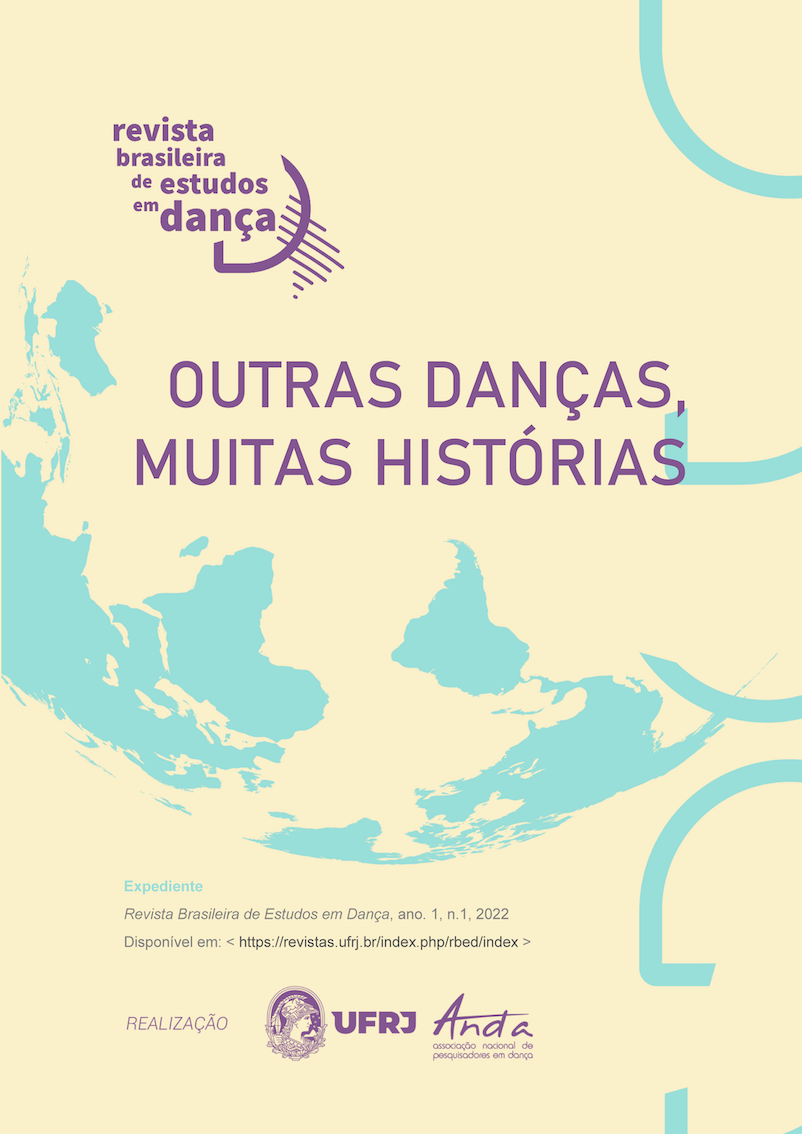Samba no pé carioca:
pistas para uma historiografia etnográfica
DOI:
https://doi.org/10.58786/rbed.2022.v1.n1.52372Palavras-chave:
decolonial, historiografia da dança, negritudeResumo
Diante dos recentes esforços decoloniais por parte de pesquisadores do sul global, procuro, neste ensaio, refletir sobre uma possibilidade de historiografia da dança partindo de uma manifestação bastante particular do Rio de Janeiro: o samba no pé urbano carioca. Para isso, proponho uma abordagem de antropofagia exusíaca, partindo do corpo como documento e com uma metodologia comparativista que se abre para diversos cruzos de saberes.
Downloads
Referências
ALBUQUERQUE, Isabela. A História Cruzada e os limites do comparativismo histórico. Fronteiras & Debates, v. 5, n. 2, p. 5-15, jul./dez. 2018.
BARROS, José D'Assunção. História Comparada. Petrópolis, RJ: Vozes, 2014.
______. Histórias Cruzadas – considerações sobre uma nova modalidade baseada nos procedimentos relacionais. Anos 90, [S. l.], v. 21, n. 40, p. 277–310, 2013.
BENTO, Cida. O pacto da Branquitude. São Paulo: Companhia das Letras, 2007
BLOCH, Marc. Os Reis Taumaturgos. São Paulo: Companhia das Letras, 1993.
______. Pour une histoire comparée des sociétés européennes. In: Melanges Historiques. v. 1. p. 16-40. Paris: EHESS, 1983.
CORSEUIL, Jacques. Apresentando Gilberto Motta. Correio da Manhã, Rio de Janeiro, 23 mar. 1958. 5º caderno, p. 6.
DETIENNE, Marcel. Comparar o incomparável. São Paulo: Ed. Ideias e Letras, 2004.
ESPAGNE, Michel. Les transferts culturels. Connections. A Journal for Historians and Area Specialists. 2005. Disponível em: www.connections.clio-online.net/debate/id/diskussionen-576. Acessado em 16 jan. 2022.
GARFINKEL, Yosef. The Evolution of Human Dance: Courtship, Rites of Passage, Trance, Calendrical Ceremonies and the Professional Dancer. Cambridge Archaeological Journal, v. 28, n. 2, p. 283-298, may 2018. DOI: 10.1017/S0959774317000865
GUARATO, Rafael. Del abandono como práctica historiográfica para una historiografía del abandono. Investigaciones en danza y movimiento, Buenos Aires, v. 01, n. 01, ano 01, p. 02-21, dezembro de 2019.
HOBSBAWM, Eric; RANGER, Terence. A invenção das tradições. São Paulo: Paz e Terra, 1997.
KAELBLE, Hartmut. Die Debatte über Vergleich und Transfer und was Jetzt? In: Connections. A Journal for Historians and Area Specialists. 2005. Disponível em: https://www.connections.clio-online.net/article/id/artikel-574 [tradução de Álvaro Alfredo Bragança Júnior]. Acessado em 16 jan. 2022.
PRANDI, Reginaldo. Mitologia dos orixás. São Paulo: Companhia das Letras, 2001.
RIBEIRO, Djamila. O que é lugar de fala? Belo Horizonte: Letramento, 2017.
ROYO, Alessandra Lopezy. Archaeology for dance: An approach to dance education. Research in Dance Education, v. 3, n. 2, p. 143-153, 2002. DOI: 10.1080/1464789022000034703.
SÀLÁMÌ, Sikiru King; RIBEIRO, Ronilda Iyakemi. Exu e a ordem do universo. São Paulo: Oduduwa, 2011.
SAID, Edward. Orientalismo. O Oriente como invenção do Ocidente. São Paulo: Companhia das Letras, 2007.
SETH, Sanjay. Razão ou Raciocínio? Clio ou Shiva? História da Historiografia, Ouro Preto, n. 11, p. 173-189, abril de 2013.
SIMAS, Luiz Antonio; RUFINO, Luiz. Flecha no Tempo. Rio de Janeiro: Mórula, 2019.
THEML, Neyde e BUSTAMENTE, Regina Maria da Cunha. História Comparada: Olhares Plurais. In: Revista de História Comparada, v. 1, n. 1, jun./2007.
VERGER, Pierre. Os orixás, os deuses iorubás na África e no novo mundo. Trad. Maria Aparecida de Nóbrega. São Paulo: Corrupio, 1993.
VIEIRA, Thaynã Fabiano do Rosário. Teoria/Metodologia Sapuca. Monografia (Licenciatura em Dança). Escola de Educação Física e Desportos, Universidade Federal do Rio de Janeiro. Rio de Janeiro, p. 72. 2021.
WERNER, Michael e ZIMMERMANN, Bénédicte. Pensar a história cruzada: entre a empiria e a reflexividade. In: Textos de História, v. 11, n. 1/ 2, p. 89-127. 2003.
Downloads
Publicado
Versões
- 2024-05-10 (4)
- 2023-12-01 (3)
- 2023-11-30 (2)
- 2022-07-15 (1)
Como Citar
Edição
Seção
Licença
As pessoas autoras que publicarem na Revista Brasileira de Estudos em Dança são os responsáveis pelo conteúdo dos artigos assinados e retém os direitos autorais. Concedem à revista o direito de primeira publicação com o trabalho simultaneamente licenciado sob a Licença Creative Commons Atribuição-Não Comercial 4.0 (Open Archives Iniciative - OAI). Esse recurso, utilizado para periódicos de acesso aberto, permite o compartilhamento do trabalho para fins não comerciais com reconhecimento da autoria. Caso o texto venha a ser publicado posteriormente em outro veículo, a pessoa autora deverá informar que o mesmo foi originalmente publicado como artigo na Revista Brasileira de Estudos em Dança. Assim sendo, ainda que a revista seja detentora da primeira publicação, é reservado às pessoas autoras o direito de publicar seus trabalhos em repositórios institucionais ou em suas páginas pessoais, mesmo que o processo editorial não tenha sido finalizado.
É reservado à revista o direito de realizar alterações de ordem normativa, ortográfica e gramatical visando manter o padrão de língua, respeitando-se, porém, o estilo autoral.

